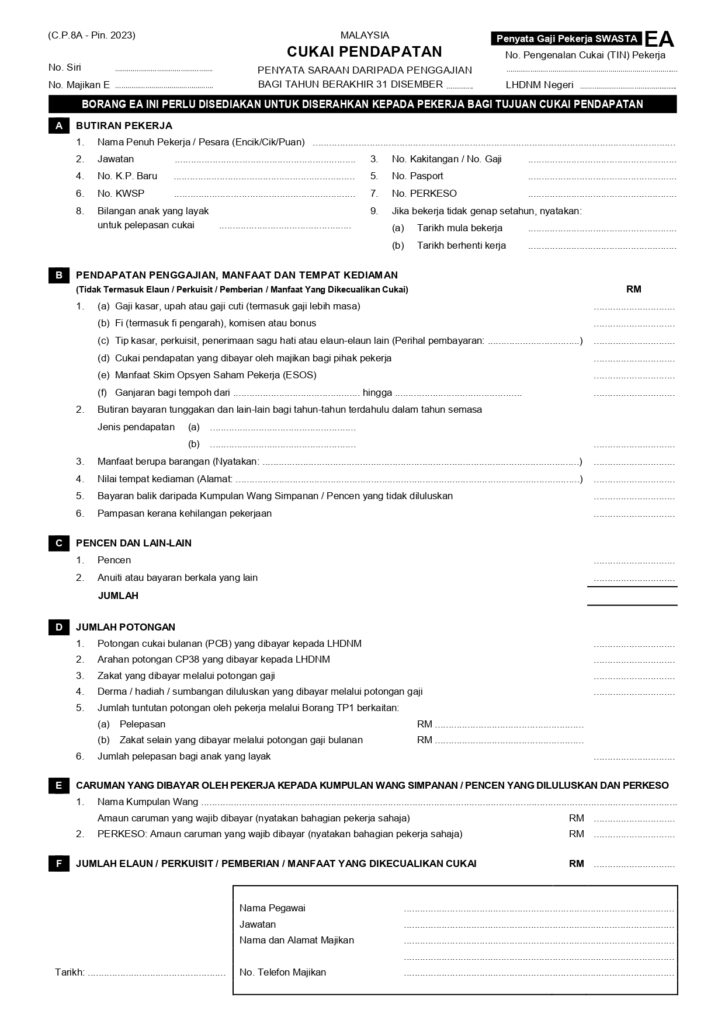Ever spotted “EA Form” in your company’s HR updates and wondered what it’s for? Or perhaps you’ve received one from your HR department and aren’t sure how it ties to your income tax?
The EA Form is one of the most important documents in Malaysia’s tax season. It summarises every employee’s salary, benefits, and deductions for the year, ensuring full compliance with LHDN (Lembaga Hasil Dalam Negeri Malaysia). Whether you’re managing payroll or preparing to file taxes, understanding this form helps both HR and employees stay compliant and avoid last-minute stress.
Table of Contents
- What Is the EA Form in Malaysia
- Why the EA Form Matters for Employers and Employees
- EA Form Deadlines and Related LHDN Forms
- Ensuring Accuracy in EA Form Preparation
- Common EA Form Mistakes to Avoid
- What’s New for EA Form Submissions
- Conclusion
- Frequently Asked Questions (FAQ)
What Is the EA Form in Malaysia
The EA Form (also known as Borang EA or C.P. 8A) is an annual statement of remuneration that each employer must issue to its employees. It details total earnings, allowances, bonuses, and statutory contributions such as EPF, SOCSO, and EIS.


Employees use this form when submitting their income tax returns, while companies must issue it by 28 February each year. Failure to issue or submit the EA Form promptly may result in penalties or fines under Section 83(1A) of the Income Tax Act 1967.
Why the EA Form Matters for Employers and Employees
The EA Form plays a critical role for both employers and employees. For individuals, it acts as proof of annual income and ensures accuracy when declaring income tax. For companies, it confirms that payroll data is correct and complies with reporting requirements.

By issuing the EA Form properly, HR teams strengthen transparency, prevent errors, and maintain compliance throughout the year.
EA Form Deadlines and Related LHDN Forms
| Task | Responsible Party | Deadline |
| Issue EA Form to employee | Employer | By 28 February |
| Submit Form E | Employer | By 31 March |
| File Form BE (Income Tax Return) | Employee | By 30 April (manual) / 15 May (e-Filing) |
Missing these deadlines can cause late submissions or penalties, so HR departments should prepare early and ensure all forms are completed on time.
Other Important Forms
| Form | Submitted By | Purpose | Deadline |
| EA Form (C.P. 8A) | Employer → Employee | Summarises earnings and deductions | 28 February |
| Form E | Employer → LHDN | Declares the total workforce and remuneration | 31 March |
| Form CP8D | Employer → LHDN | e-Submission of EA Form details | 31 March |
| Form BE | Employee → LHDN | Individual income tax return | 30 April (manual) / 15 May (e-Filing) |
| Form CP22A/B | Employer → LHDN | Resignation or retirement notice | 30 days before final payment |
Keeping track of these forms ensures smoother tax submissions and avoids last-minute confusion.
Ensuring Accuracy in EA Form Preparation
Accuracy is vital when preparing the EA Form. Even small mistakes, such as an incorrect figure or missing deductions, can lead to issues during audits or tax filings.
Employers should double-check all payroll data, including overtime, bonuses, allowances, and statutory deductions. Consistent payroll records throughout the year make it easier to prepare accurate EA Forms.
Using reliable payroll systems helps teams generate and verify the EA Form efficiently, reducing the time needed for manual checks.
Common EA Form Mistakes to Avoid
Even experienced HR teams can make errors when preparing the EA Form. Some of the most common include:
- Missing the 28 February deadline
- Forgetting a resigned employee
- Using outdated templates
- Incorrect figures or deduction details
- Mismatch between EA Form and Form E data
By reviewing payroll records early, HR can correct discrepancies before submission and save time when finalising tax documents.
What’s New for EA Form Submissions

As the 2026 tax season approaches, employers will soon need to prepare EA Forms for earnings received in 2025. All EA Forms must be issued to employees by 28 February 2026, and Form E must be submitted by 31 March 2026.
It’s best for HR teams to start preparations early, ensuring that payroll records, allowances, and deductions are accurate before submission. The e-Data Praisi System remains the preferred platform for online submission, offering faster validation and reducing manual errors.
Conclusion
The EA Form is more than just a yearly document for tax reporting; it reflects how well a company manages HR and payroll compliance. Timely, accurate submissions build trust and prevent costly penalties.
For HR professionals, understanding how to prepare and issue the EA Form correctly forms part of a strong HR foundation. With structured systems like TimeTec HR and TimeTec Payroll in place, managing data and statutory compliance becomes more efficient and streamlined for what truly matters, your workforce.
Frequently Asked Questions (FAQ)
1. Do employees need to submit the EA Form to LHDN?
No. Companies submit data directly to LHDN. Recipients only use the EA Form to declare their annual income tax.
2. What if I worked for two companies in one year?
You’ll receive two EA Forms. One from each organization, covering your respective employment periods for that assessment year.
3. How can companies simplify EA Form preparation?
Automating HR and payroll tasks can reduce manual work. Platforms such as TimeTec HR and TimeTec Payroll generate EA Forms automatically based on income and statutory data, ensuring full compliance with LHDN’s requirements.


